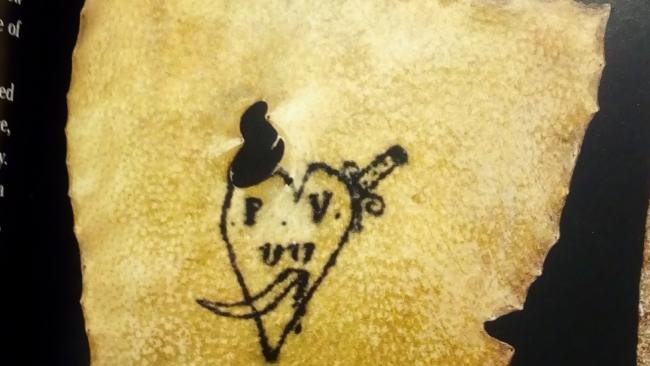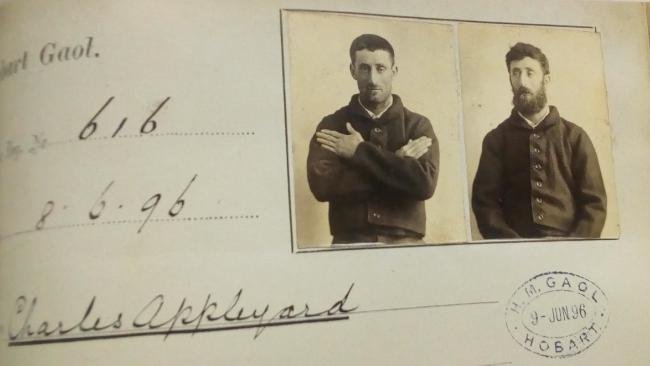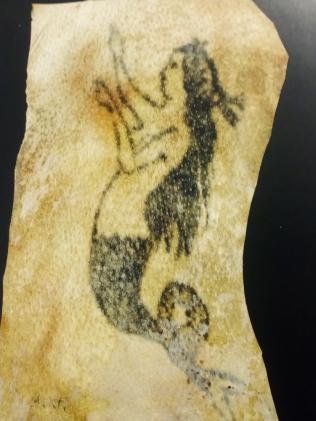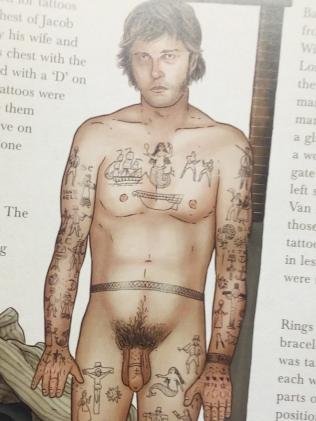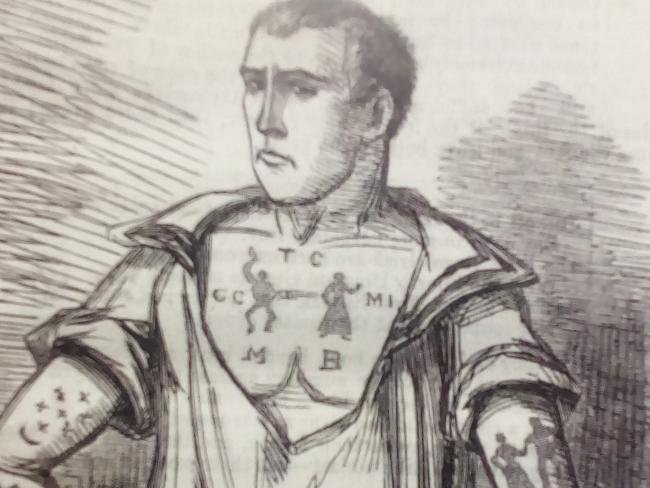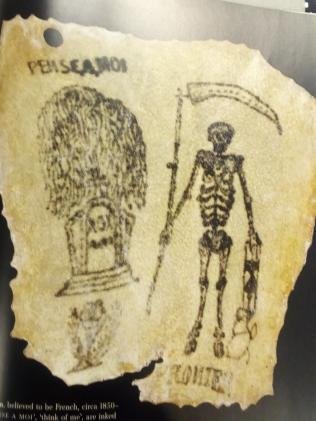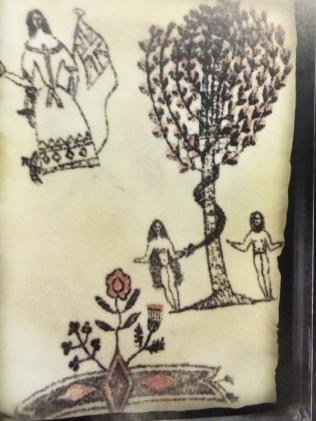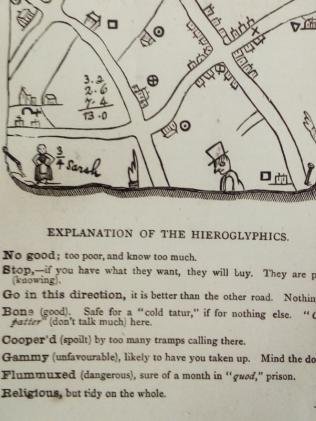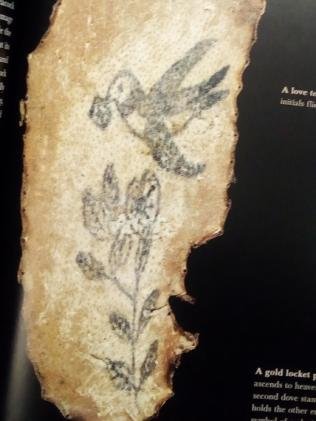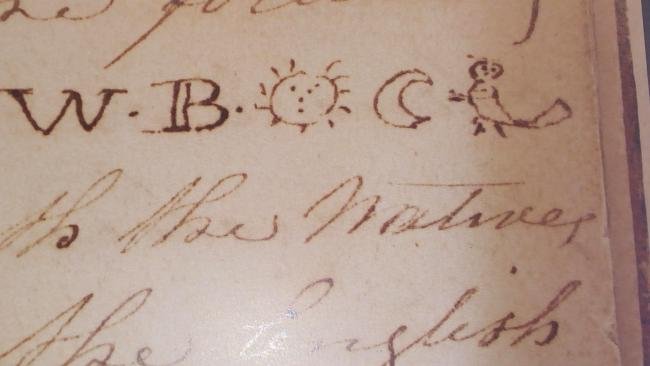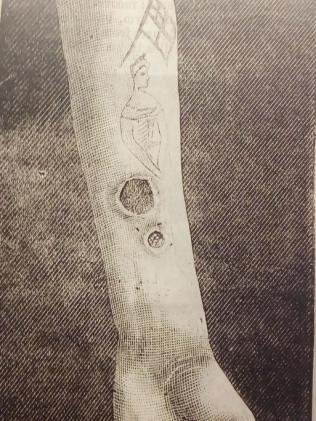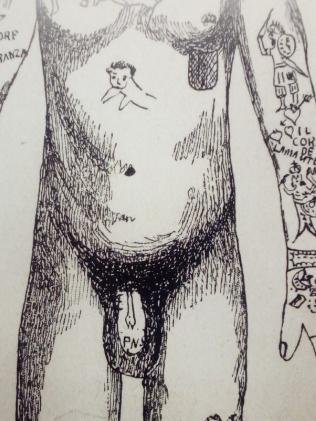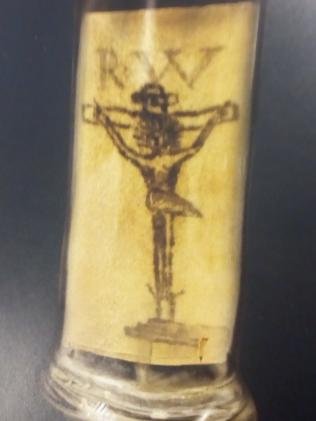Tattooed human skin with a heart pierced with a dagger, symbolising betrayal or loss, and the initials P.V.VV. Circa 1850-1900. Picture: CS/Science & Society Picture Library
T WAS a time when Australia was one of the most tattooed nations in the world and the male female convicts arriving in the penal colonies were heavily inked with symbols that had secret meanings and codes.
Of the 160,000 convicts transported to Australia, at least 37 per cent of males and 15 per cent of the women were tattooed when they arrived.Many bore names and initials of loved ones never to be seen again, or masonic or religious symbols, images from illustrated Bibles, tableware of the time, animals, mermaids, ships and true love knots.According to a new book by colonial era author Simon Barnard, mermaids represented both beauty but also fear for “their habit of luring soldiers to watery graves”.Convicts were also tattooed with mermen, and sightings and belief of both creatures’ existence persisted into the late 19th century and may have been inspired by dugongs or similar sea creatures.
The penal records of convicts like Charles Appleyard (above) recorded their bodily markings which included tattoos found on a remarkable 37pc of men and 15pc of women. Picture: CS/Convict TattoosSource:Supplied
Human skin featuring a tattooed mermaid which symbolised both love and peril on a sea voyage, a French relic from 1850-1900. Picture: CS/Science & Society Picture LibrarySource:Supplied
Thirty-one-year-old convict Isaac Comer’s tattoos included ‘seven stars, two rings, and an anchor between legs ... on his yard’, a yard being colonial parlance for penis. Picture: CS/Convict TattoosSource:Supplied
The tattoos of our first boat arrivals represented love or hope, beliefs or patriotic sentiments in the form of statements, Barnard said, but also “expressed sorrow, humour, regret, defiance and allegiance”.A cluster of seven stars — representing the constellation of Taurus — was popular on the arms of convicts and represented the sacred seven daughters of the Greek god Zeus, but also life, death, eternity, guidance and protection.Tattoos of pugilists or boxing men had “celebrity status” in the 19th century and “may have been a form of intimidation, a warning that the bearer was not to be trifled with”.Drawings of convicts’ tattoos and photographs of tattooed skin retained from the era in Barnard’s book, Convict Tattoos, show tattoos on arms, chests, legs and private parts, such as warriors on the biceps, a snake on the penis, doves and suns on arms and wrists, and secret symbols which were “hieroglyphics” in the form of pictograms.
Convict, Miles Confrey, 23, displaying his tattoos including a fighting man, woman and seven stars on his right arm, symbolising guidance and eternity. Picture: Convict TattoosSource:Supplied
Tattooed human skin circa 1850-1900 with weeping willow symbolising grief and eternal life, and the grim reaper with a scythe, and the words ‘pense a Moi’ meaning ‘think of me”. Picture: Convict TattoosSource:Supplied
Tattooed human skin from 1800-50 with a woman, perhaps hope, with the British ensign and (right) Adam and Eve with the Tree of Life plus the shamrock, rose and thistle, front. Picture: Convict TattoosSource:Supplied
Elson’s penal record noted his tattoos as “woman & tree inside rt. arm, beehives and bees between two buses inside left arm, ring pricked on little finger rt. hand”.Female convict Ann Gough, transported for seven years for stealing money, had a mermaid and an anchor on her left arm, and initials, a heart and two stars on her right arm.Heart tattoos predominantly expressed undying affection, and pierced with darts referred to erotic love.A bleeding or wounded heart may symbolise a heart broken in two, while a heart skewered with a dagger symbolised betrayal or loss. A pansy represented the French for to think of, “penser”.The skull and crossbones, also called a Jolly Roger, was a popular symbol of pirates, but some convict skull tattoos also featured a crucifix, to symbolise eternal life.A weeping willow, symbolising grief and eternal life was also a favourite.Barnard writes that when the convict ship the Moffatt docked in Van Diemen’s Land (later Tasmania) in 1834, 17 men tattooed with willow trees disembarked.A true love knot, often tattooed on the inside of the arm, a personal place, represented enduring devotion by the fact the more the ends of the knot are pulled, the tighter it becomes.
Drawing from the 1889 British Medical Journal of a tattooed arm with syphilitic sores spread by a tattooist who ‘mixed ink with spittle from his syphilitically ulcerated mouth’. Picture: CS/Convict TattoosSource:Supplied
A convict’s tattoos including a warrior, hearts and a mermaid on the left arm and a snake on the ‘yard’, a colonial term for penis. Picture: CS/Convict TattoosSource:Supplied
ATTOOS ON THE BODYTattoos on the heads of convicts were rare, and few convicts had symbol inked on their abdomen. Nor do back tattoos feature in convict descriptions of body markings.But elsewhere, tattoos featured, particularly on arms and hands.ARMSThe most commonly tattooed place for convicts, with forearms popular and the left arm most common, suggesting many tattoos were self-made.GROINSome male convicts, though not many, had tattoos of stars, rings or a snake on their penis, more politely referred to in colonial times as their ‘yard’.SHOULDERS
A more common place for tattoos on women than men. Simon Barnard wrote that a woman convict, Elizabeth Smith had “I L Heart” and a wreath on her right shoulder.
source >news.com.au

